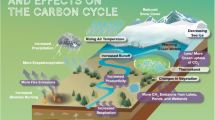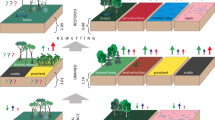Abstract
Localized permafrost disturbances such as active layer detachments (ALDs) are increasing in frequency and severity across the Canadian Arctic impacting terrestrial ecosystem functioning. However, the contribution of permafrost disturbance-carbon feedbacks to the carbon (C) balance of Arctic ecosystems is poorly understood. Here, we explore the short-term impact of active layer detachments (ALDs) on carbon dioxide (CO2) exchange in a High Arctic semi-desert ecosystem by comparing midday C exchange between undisturbed areas, moderately disturbed areas (intact islands of vegetation within an ALD), and highly disturbed areas (non-vegetated areas due to ALD). Midday C exchange was measured using a static chamber method between June 23 and August 8 during the 2009 and 2010 growing seasons. Results show that areas of high disturbance had significantly reduced gross ecosystem exchange and ecosystem respiration (R E) compared to control and moderately disturbed areas. Moderately disturbed areas showed significantly enhanced net ecosystem exchange compared to areas of high disturbance, but were not significantly different from control areas. Disturbance did not significantly impact soil thermal, physical or chemical properties. According to average midday fluxes, ALDs as a whole (moderately disturbed areas: −1.942 μmol m−2 s−1+ highly disturbed areas: 2.969 μmol m−2 s−1) were a small CO2 source of 1.027 μmol m−2 s−1 which did not differ significantly from average midday fluxes in control areas 1.219 μmol m−2 s−1. The findings of this study provide evidence that the short-term impacts of ALDs on midday, net C exchange and soil properties in a High Arctic semi-desert are minimal.







Similar content being viewed by others
References
ACIA (2004) Arctic climate impact assessment. Impacts of a warming arctic: Arctic climate impact assessment. Cambridge University Press, Cambridge
Bosquet L (2010) The effects of observed and experimental climate change and permafrost disturbance on tundra vegetation in the western Canadian High Arctic. Unpublished MSc. Thesis, Queen’s University
Bowden WB, Gooseff MN, Balser A, Green A, Peterson BJ, Bradford J (2008) Sediment and nutrient delivery from thermokarst features in the foothills of the North Slope, Alaska: potential impacts on headwater stream ecosystems. J Geophys Res. doi:10.1029/2007JG000470
Burn CR, Lewkowicz AG (1990) Retrogressive thaw slumps. Can Geogr 34(3):273–276
Chapman WL, Walsh JE (1993) Recent variations of sea ice and air temperature in high latitudes. Bull Am Meteorol Soc 74:33–47
Dane JH, Topp C (2002) Part 4: physical methods. In: Al-Amoodi L, Dick WA (eds) Methods of soil analysis. Soil Science Society of America, Inc., Madison, pp 903–916
Davidson EA, Janssens IA (2006) Temperature sensitivities of soil carbon decomposition and feedbacks to climate change. Nature 440:165–173
Dyke AS, Savelle JM (2000) Major end moraines of Younger Dryas age on Wollaston Peninsula, Victoria Island, Canadian Arctic: implications for paleoclimate and for formation of hummocky moraine. Can J Earth Sci 37:601–619
Elmendorf SC, Henry GHR, Hollister RD, Björk RG, Björkman AD, Callaghan TV, Collier LS, Cooper EJ, Cornelissen JHC, Day TA, Fosaa AM, Gould WA, Grétarsdóttir J, Harte J, Hermanutz L, Hik DS, Hofgaard A, Jarrad F, Jónsdóttir IS, Keuper F, Klanderud K, Klein JA, Koh S, Kudo G, Lang S, Loewen V, May JL, Mercado J, Michelsen A, Molau U, Myers-Smith IH, Oberbauer SF, Pieper S, Post E, Rixen C, Robinson CH, Schmidt NM, Shaver GR, Stenstro MA, Tolvanen A, Totland Ø, Troxler T, Wahren CH, Webber PJ, Welker JM, Wookey PA (2012) Global assessment of experimental climate warming on tundra vegetation: heterogeneity over space and time. Ecol Lett 15(2):164–175
Fahnestock JT, Jones MH, Brooks PD, Walker DA, Welker JM (1998) Winter and early spring CO2 efflux from tundra communities of northern Alaska. J Geophys Res-Atmos 103:29023–29027
Forland EJ, Hanssen-Bauer I (2000) Increased precipitation in the Norwegian Arctic: true or false? Clim Change 46:485–509
Grogan P, Jonasson S (2005) Temperature and substrate controls on intra-annual variation in ecosystem respiration in two subarctic vegetation types. Glob Chang Biol 11:465–475
Grosse G, Harden J, Turetsky M, McGuire AD, Camill P, Tarnocai C, Frolking S, Schuur EAG, Jorgenson T, Marchenko S, Romanovsky V, Wickland KP, French N, Waldrop M, Bourgeau-Chavez L, Striegl RG (2011) Vulnerability of high-latitude soil organic carbon in North America to disturbance. J Geophys Res. doi:10.1029/2010JG001507
Hutchinson GL, Mosier AR (1981) Improved soil cover method for field measurement of nitrous oxide flux. Soil Sci Soc Am J 45:311–316
Jorgenson MT, Osterkamp TE (2005) Response of boreal ecosystems to varying modes of permafrost degradation. Can J For Res 35:2100–2111
Kutzbach L, Schneider J, Sachs T, Giebels M, Nykanen H, Shurpali NJ, Martikainen PJ, Alm J, Wilmking M (2007) CO2 flux determination by closed-chamber methods can be seriously biased by inappropriate application of linear regression. Biogeosciences 4:1005–1025
Lacelle D, Bjornson J, Lauriol B (2010) Climatic and geomorphic factors affecting contemporary (1950–2004) activity of retrogressive thaw slumps on the Aklavik Plateau, Richardson Mountains, MWT, Canada. Permafr Periglac 21(1):1–15
Lafleur PM, Humphreys ER, St. Louis V, Myklebust MC, Papakyriakou T, Poissant L, Barker JD, Pilote M, Swystun KA (2012) Variation in peak growing season net ecosystem production across the Canadian Arctic. Environ Sci Technol 46:7971–7977
Lamoureux SF, Lafrenière MJ (2009) Fluvial impact of extensive active layer detachments, Cape Bounty, Melville Island, Canada. Arct Antarct Alp Res 41:59–68
Lantz TC, Kokelj SV (2008) Increasing rates of retrogressive thaw slump activity in the Mackenzie Delta region, N.W.T., Canada. Geophys Res Lett 15:1664–1675
Lewis T, Lafrenière MJ, Lamoureux SF (2012) Hydrochemical and sedimentary response of paired High Arctic watersheds to unusual climate and permafrost disturbance, Cape Bounty, Melville Island, Canada. Hydrol Process 26:2003–2018
Lewkowicz AG (2007) Dynamics of active-layer detachment failures, Fosheim Peninsula, Ellesmere Island, Nunavut, Canada. Permafr Periglac 18:89–103
Lewkowicz AG, Harris C (2005) Frequency and magnitude of active-layer detachment failures in discontinuous and continuous permafrost, northern Canada. Permafr Periglac 16:115–130
Mathewson CC, Mayer-Cole TA (1984) Development and runout of a detachment slide, Bracebridge Inlet, Bathurst Island. Northwest Territories, Canada. Bull Assoc Eng Geol 21:407–424
McGuire AD, Anderson LG, Christensen TR, Dallimore S, Guo L, Hayes DJ, Heimann M, Lorenson TD, Macdonald RW, Roulet N (2009) Sensitivity of the carbon cycle in the Arctic to climate change. Ecol Monogr 79:523–555
Nobrega S, Grogan P (2007) Deeper snow enhances winter respiration from both plant-associated and bulk soil carbon pools in birch hummock tundra. Ecosystems 10:419–431
Oechel WC, Vourlitis G, Hastings SJ (1997) Cold season CO2 emission from arctic soils. Global Biogeochem Cycle 11(2):163–172
Osterkamp TE, Jorgenson MT, Schuur EAG, Shur YL, Kanevskiy MZ, Vogel JG, Tumskoy VE (2009) Physical and ecological changes associated with warming permafrost and thermokarst in interior Alaska. Permafr Periglac 20:235–256
Schuur EAG, Blackheim J, Canadell JG, Euskirchen E, Field C, Goryachkin S, Hagemann S, Kuhry P, Lafleur P, Lee H (2008) Vulnerability of permafrost carbon to climate change: implications for the global carbon cycle. Bioscience 58:701–714
Schuur EAG, Vogel JG, Crummer KG, Lee H, Sickman JO, Osterkamp TE (2009) The effect of permafrost thaw on old carbon release and net carbon exchange from tundra. Nature 459:556–559
Schuur EAG, Abbott BW, Bowden WB, Brovkin V, Camill P, Canadell JP, Chapin FS III, Christensen TR, Chanton JP, Ciais P, Crill PM, Crosby BT, Czimczik CI, Grosse G, Hayes DJ, Hugelius G, Jastrow JD, Kleinen T, Koven CD, Krinner G, Kuhry P, Lawrence DM, Natali SM, O’Donnell JA, Ping CL, Rinke A, Riley WJ, Romanovsky VE, Sannel ABK, Schadel C, Schaefer K, Subin ZM, Tarnocai C, Turetsky M, Walter-Anthony KM, Wilson CJ, Zimov SA (2011) High risk of permafrost thaw. Nature 480:32–33
Shur YL, Jorgenson MT (2007) Patterns of permafrost formation and degradation in relation to climate and ecosystems. Permafr Periglac 18(1):7–19
Sitch S, McGuire AD, Kimball J, Gedney N, Gamon J, Engstrom R, Wolf A, Zhuang Q, Clein J, McDonlad KC (2007) Assessing the carbon balance of circumpolar Arctic tundra using remote sensing and process modeling. Ecol Appl 17:213–234
Sturm M, Racine C, Tape K (2001) Climate change—increasing shrub abundance in the Arctic. Nature 411:546–547
Turetsky MR, Wieder RK, Vitt DH, Evans RJ, Scott KD (2007) The disappearance of relict permafrost in boreal North America: effects on peatland carbon storage and fluxes. Glob Chang Biol 13(9):1922–1934
Zimov SA, Davidov SP, Voropaev YV, Prosiannikov SF, Semiletov IP, Chapin MC, Chapin FS (1996) Siberian CO2 efflux in winter as a CO2 source and cause of seasonality in atmospheric CO2. Clim Change 33(1):111–120
Acknowledgments
We would like to thank the Natural Sciences and Engineering Research Council of Canada, International Polar Year, Northern Students Training Program and ArticNet for their financial contributions to this project. Also thanks to the project PI’s: Scott Lamoureux, Melissa Lafreniere, and Paul Treitz for ongoing project support at CBAWO.
Author information
Authors and Affiliations
Corresponding author
Rights and permissions
About this article
Cite this article
Beamish, A., Neil, A., Wagner, I. et al. Short-term impacts of active layer detachments on carbon exchange in a High Arctic ecosystem, Cape Bounty, Nunavut, Canada. Polar Biol 37, 1459–1468 (2014). https://doi.org/10.1007/s00300-014-1536-4
Received:
Revised:
Accepted:
Published:
Issue Date:
DOI: https://doi.org/10.1007/s00300-014-1536-4




